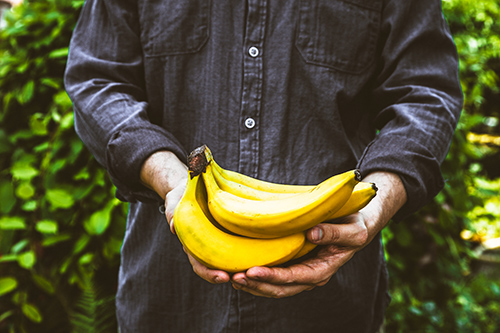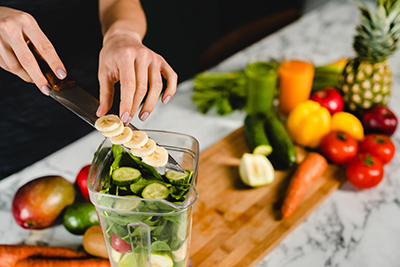Contents
After the apple, the benefits of eating bananas are the most well-known and consumed worldwide. It is on the five continents due to its ease of use: a banana can be eaten wherever without needing a napkin or a knife. It even comes wrapped in its own natural hygienic “packaging”—its peel—that protects it from contamination. But more than anything, bananas are one of the most nutritious and medicinal fruits.

Bananas Scientific Facts
- Scientific name – Musa x paradisiaca L. var. sapientum.
- French – Banane.
- Spanish – Plátano, banana.
- German – Banane.
- Description – This is the aggregate fruit of the banana tree, a hybrid species formed from two others. It is a bush of the botanical family Musaceae that reaches a height of three to five meters. The bananas grow in bunches weighing as much as 50 kg and containing as many as 300 pieces.
- Environment—Originally from Southeast Asia, its cultivation has extended throughout tropical and subtropical regions in Africa and America.
Banana Nutritional Information
Carbohydrates are prominent in the banana’s composition (up to 21 percent). Unripe bananas are made up mainly of starch. As they ripen, this starch converts to sugars such as saccharose, glucose, and fructose. About one percent of starch remains in a ripe banana, which is not difficult if it is well chewed.

However, unripe or green bananas contain significant amounts of starch that is difficult to digest and can cause flatulence (intestinal gas) and dyspepsia (indigestion). Bananas contain a small number of proteins (one percent) and minimal fats (less than 0.5 percent).
Bananas stand out for their vitamin B6 content. About three medium-sized bananas provide the recommended daily allowance of this vitamin for an adult male. Bananas also contain vitamins C, B1, B2, E, and folate. Bananas are also exceptionally rich in minerals, including potassium, magnesium, and iron.
Their rich potassium content makes them one of this mineral’s best fresh fruit sources: only the avocado and the date surpass the banana in potassium. Both types of vegetable fiber, soluble and insoluble, are present in significant amounts in bananas, as far as fruit is concerned: 2.4 grams/100 grams. This fiber contributes to the banana’s hypolipidemic (lipid and cholesterol-lowering) and intestinal-soothing effects.
Bananas contain small amounts of SEROTONIN. This substance, derived from the amino acid tryptophan, performs various functions within the nervous system, such as arterial vasodilation, inhibition of pain in the spinal cord, and sedation of the nerves. The effect of the small amounts of serotonin in bananas on the body is still being studied.
Benefits of Eating Bananas
The banana’s medicinal applications are as follows:
Coronary disease – Bananas are an ideal fruit for those suffering from coronary disease (angina, myocardial infarction, arrhythmia, heart failure) or circulatory system disorders (arterial hypertension, arteriosclerosis) because of their exceptional composition:
- Their richness in potassium and the absence of sodium: with 396 mg of potassium and one gram of sodium per 100 grams of edible portion, the banana has the highest potassium/sodium quotient of any fruit or vegetable (meat, fish, and dairy products have much less potassium and more sodium). A diet rich in potassium and low in sodium inhibits arterial hypertension, arrhythmia, stroke, and cancer.
- The presence of significant amounts of B group vitamins, necessary for energy production within the heart muscle, and magnesium inhibits the progress of arteriosclerosis and prevents heart attack.
- Abundant vegetable fiber that lowers cholesterol levels.
- Small amounts of serotonin act as a vasodilator.

Intestinal disorders—Bananas alone or with apples effectively relieve diarrhea in children and adults. They are also effective for those with celiac disease (poor intestinal absorption accompanied by diarrhea and undernourishment produced by an allergy to gluten) and may be eaten abundantly or even exclusively for some days. Bananas, along with corn and rice, are an excellent food for those who suffer from this disorder.
Uric arthritis and gout – Bananas alkalize the blood, which helps neutralize and eliminate the excess uric acid that causes arthritis and gout.
Low-sodium diet—Bananas are the ideal fruit whenever a low-sodium diet is called for since they provide calories, vitamins, and other minerals. They are recommended in cases of cirrhosis, ascites (accumulation of fluid in the peritoneal cavity), and edema (retention of watery fluid in the tissues) caused by cardiac or renal nephritis, nephrosis, or kidney failure.
Diabetes – Bananas are not contraindicated for diabetics, although the use of the carbohydrates they contain in the form of sugars must be controlled. In contrast to refined sugars (white sugar), those found in bananas are absorbed more slowly and do not sharply increase blood glucose (sugar) levels.
Bananas and Gastroduodenal Ulcers
Bananas have traditionally been used in diets for ulcers because they neutralize excess stomach acid while protecting the mucosa. Their use is equally beneficial in any dyspepsia (digestive disturbance). However, investigations in India show that bananas are less effective than oatmeal in reducing stomach acid. In some cases, bananas may increase gastric juice production. Because of this, bananas should not be indiscriminately in the diets of people who suffer from ulcers.

Different Varieties of Bananas
- Plantain—This type of banana is cultivated in many central and South American regions and Africa. It is more significant and much less sweet but is rich in starch and potassium. It should not be eaten raw; it lends itself to all cooked dishes, like potatoes. Plantains also produce flour that may be used even in bread making. This type of banana is a staple food in many tropical regions.
- Red banana—This variety of bananas from Malaysia has a dark red peel and a flavor similar to that of the typical banana. It is eaten raw.
- Dwarf bananas are smaller, sweeter, and more flavorful than the standard banana. They are raised in the Canary Islands and Southeast Asia.
How to use Bananas
- Raw – This is the best way to consume it. We must remember that all bananas consumed in non-producing countries are collected unripe and artificially ripened in chambers. This process causes them to have fewer sugars and vitamins than those ripened on the tree.
- Cooked in different ways: most vitamins are lost this way, although carbohydrates, minerals, and other nutrients remain. The most often cooked variety is plantain, which is rich in starch.
| # | Preview | Product | Rating | |
|---|---|---|---|---|
| 1 |

|
Banana Bunch (4-5 Count) | Check Price | |
| 2 |

|
Organic Banana | Check Price | |
| 3 |

|
Organic Banana Bunch (4-5 Count) | Check Price | |
| 4 |

|
Banana | Check Price | |
| 5 |

|
Organic Strawberries, 1 Lb | Check Price |
DISCLAIMER: All content on this website is presented solely for educational and informational objectives. Do not rely on the information provided as a replacement for advice, diagnosis, or treatment from a qualified medical expert. If you are pregnant, nursing, or have any preexisting medical concerns, talk to your doctor before using any herbal or natural medicines.
REFERENCES
- George D. Pamplona-Roger, M.D. “Encyclopedia of Foods and Their Healing Power.” George D. Pamplona-Roger, M.D. Encyclopedia of Foods and Their Healing Power. Trans. Annette Melgosa. Vol. 2. Chai Wan: Editorial Safeliz, 2005. 370,371. Print. [benefits of eating bananas]
- https://www.health.com/bananas-8413931
- https://www.webmd.com/food-recipes/health-benefits-bananas
Last update on 2025-06-04 / Affiliate links / Images from Amazon Product Advertising API
